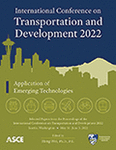A Machine Learning Approach to Improving Accuracy of WIM Traffic Data
Publication: International Conference on Transportation and Development 2022
ABSTRACT
Weigh-in-motion (WIM) devices classify each passing vehicle into one of the 13 types of vehicles defined by the Federal Highway Administration according to the axle configurations of the vehicle. Accurate vehicle classifications are pivotal for pavement design as they are the main parts of the required design input. However, it is often found that there exist sizable misclassified vehicles in the WIM recorded data. These misclassified vehicles would have major adverse effects on pavement design. This paper presents a study using a machine learning algorithm to identify misclassified vehicles and reclassify them into the appropriate vehicle categories. A video captured near a WIM station was utilized in combination with the WIM recorded data in the machine learning algorithm. The main features of the correctly classified vehicles and the misclassified vehicles were identified and utilized in the training and testing procedures. It proved in this study that the machine learning method could identify the majority of the misclassified vehicles and placed them into the correct vehicle groups. Consequently, the accuracy of the WIM recorded traffic data can be significantly improved, and the quality of pavement design can be greatly enhanced.
Get full access to this article
View all available purchase options and get full access to this chapter.
REFERENCES
Adu-Gyamfi, Y., Asare, S., Sharma, A., and Titus, T. (2017). “Automated vehicle recognition with deep convolutional neural networks.” Transportation Research Record: Journal of the Transportation Research Board, 2645 (1), pp 113–122. https://doi.org/10.3141/2645-13.
Alavi, A., Jiao, P., Buttlar, W., and Lajnef, N. (2018). “Internet of things-enable smart cities: state-of-the-art and future trends.” Measurement, 129, pp 589–606. https://doi.org/10.1016/j.measurement.2018.07.067.
Breiman, L. (2001). “Random forests.” Machine Learning, 4, pp 5–32. https://doi.org/10.1023/A:1010933404324.
Chen, Z., Pears, N., Freeman, M., and Austin, J. (2014). “A gaussian mixture model and support vector machine approach to vehicle type and colour classification.” IET intelligent transportation systems. 8(2). https://doi.org/10.1049/iet-its.2012.0104.
Dhingra, S., Madda, R., Patan, R., Jiao, P., Barri, K., and Alavi, A. (2021). “Internet of things-based fog and cloud computing technology for smart traffic monitoring.” Internet of Things, 14, pp 2542–6605. https://doi.org/10.1016/j.iot.2020.100175.
FHWA (Federal Highway Administration). (2016). Traffic monitoring guide, pp 18–22. Washington, D.C.: Federal Highway Administration (FHWA), US Department of Transportation. Retrieved March 8, 2021 from https://www.fhwa.dot.gov/policyinformation/tmguide/tmg_fhwa_pl_17_003.pdf.
He, P., Wu, A., Huang, X., Scott, J., Rangarajan, A., and Ranka, S. “Deep learning based geometric features for effective truck selection and classification from highway videos.” 2019 IEEE Intelligent Transportation Systems Conference (ITSC), 2019, pp 824–830. Doi: https://doi.org/10.1109/IRSC.2019.8917097.
Inoue, J., Yamagata, Y., Chen, Y., Poskitt, C., and Sun, J. (2017). “Anomaly detection for a water treatment system using unsupervised machine learning.” 2017 IEEE International Conference on Data Mining Workshops (ICDMW), 2017, pp 1058–1065. Doi: https://doi.org/10.1109/ICDMW.2017.149.
Javadi, S., Rameez, M., Dahl, M., and Pettersson, M. (2018). “Vehicle classification based on multiple fuzzy c-means clustering using dimensions and speed features.” Procedia Computer Science, 126, pp 1344–1350. https://doi.org/10.1016/j.procs.2018.08.085
Li, X., and Xu, J. (2008). “Automatic vehicle classification based on video with BP neural networks.” IEEE 4th international Conference on Wireless Communications, Networking and Mobile Computing, 2008, pp 1–3. Doi: https://doi.org/10.1109/WiCom.2008.3060.
Lin, P., Ye, K., and Xu, C. (2019). “Dynamic network anomaly detection system by using deep learning techniques.” International Conference on Cloud Computing, 2019, pp 161–176. https://doi.org/10.1007/978-3-030-23502-4_12.
Narayana, V., Gopi, A., Khadherbhi, S., and Pavani, V. (2020). “Accurate identification and detection of outliers in networks using group random forest methodology.” Journal of Critical Reviews, 7(6), pp 381–384.
Naseer, S., Saleem, Y., Khalid, S., Bashir, M., Han, J., Iqbal, M., and Han, K. (2018). “Enhanced network anomaly detection based on deep neural networks.” IEEE Access, 6, pp 48231–48246. Doi: https://doi.org/10.1109/ACCESS.2018.2863036.
NCHRP. (2004). Guide for Mechanistic-Empirical Design of New and Rehabilitated Pavement Structures., ERES Consultants Division, ARA Incorporation. Retrieved from https://onlinepubs.trb.org/onlinepubs/archive/mepdg/2appendices_gg.pdf.
Peng, C., Jiang, Y., Li, S., and Nantung, T. (2021). “Neural network optimal model for classification of unclassified vehicles in Weigh-in-Motion traffic data.” Transportation Research Record: Journal of the Transportation Research Board, 2675 (7), pp 11–23. https://doi.org/10.1177/0361198121990670.
Sarikan, S. S., Ozbayoglu, A. M., and Zilci, O. (2017). “Automated vehicle classification with image processing and computational intelligence.” Procedia Computer Science, 114(2017), pp 515–522. https://doi.org/10.1016/j.procs.2017.09.022.
Sowmya, V., and Radha, R. (2020). “Efficiency-optimized approach-vehicle classification features transfer learning and data augmentation utilizing deep convolutional neural networks.” International Journal of Applied Engineering Research. 15 (4), pp 372–376. Retrieved September 3, 2020 from http://www.ripublication.com/ijaer20/ijaerv15n4_08.pdf.
Vatani, R., Olcay, N., and Mecit, S. (2019). “Transfer learning using deep neural networks for classification of truck body types based on side‑fire lidar data.” Journal of Big Data Analytics in Transportation, 1(1), pp 71–82. https://doi.org/10.1007/s42421-019-00005-9.
Information & Authors
Information
Published In
History
Published online: Aug 31, 2022
Authors
Metrics & Citations
Metrics
Citations
Download citation
If you have the appropriate software installed, you can download article citation data to the citation manager of your choice. Simply select your manager software from the list below and click Download.
